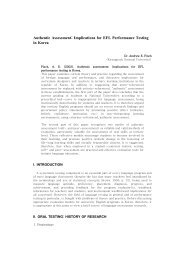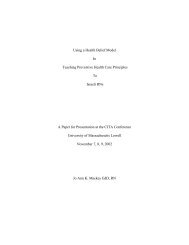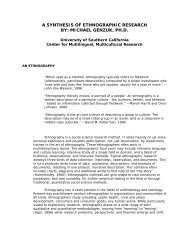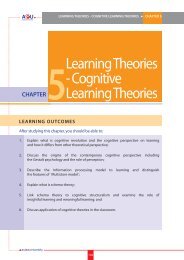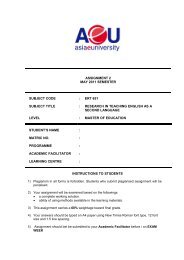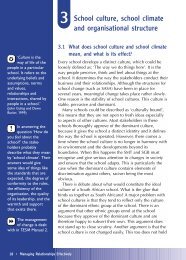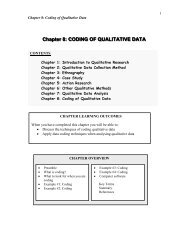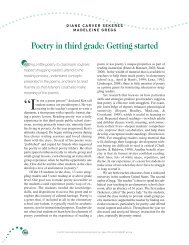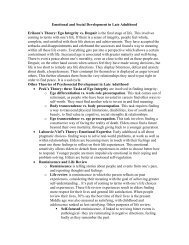Teaching Romeo and Juliet to ESL Students in ... - learningdomain
Teaching Romeo and Juliet to ESL Students in ... - learningdomain
Teaching Romeo and Juliet to ESL Students in ... - learningdomain
Create successful ePaper yourself
Turn your PDF publications into a flip-book with our unique Google optimized e-Paper software.
We can benefit from Shakespeare’s use of language <strong>to</strong> help our students underst<strong>and</strong>their world better <strong>and</strong>, therefore, our goal would be <strong>to</strong> enable them <strong>to</strong> express theirfeel<strong>in</strong>gs more accurately by giv<strong>in</strong>g their personal op<strong>in</strong>ions <strong>and</strong> treatment <strong>to</strong> certa<strong>in</strong> <strong>to</strong>pics<strong>in</strong> their second language.The f<strong>in</strong>al goal of my unit will be <strong>to</strong> see my students on a school stage perform<strong>in</strong>g acondensed 30-m<strong>in</strong>ute version of the play. We should bear <strong>in</strong> m<strong>in</strong>d that Shakespearewrote the play <strong>to</strong> be acted, not <strong>to</strong> be read. They will feel the experience of be<strong>in</strong>g ac<strong>to</strong>rs <strong>in</strong>front of an audience for the first time <strong>and</strong> become more self-confident.Shakespeare <strong>and</strong> <strong>ESL</strong> <strong>Students</strong>Once “What <strong>to</strong> teach” <strong>and</strong> “Why <strong>to</strong> teach” is set, the next step is <strong>to</strong> decide “How” <strong>and</strong>“To Whom” I am go<strong>in</strong>g <strong>to</strong> teach it. Accord<strong>in</strong>g <strong>to</strong> my students’ background, most of themcome from immigrant families from all over the world with very low <strong>and</strong> pooreducational levels. We should take <strong>in</strong><strong>to</strong> account two facts:First, only few students have access <strong>to</strong> computers, dictionaries, encyclopedias, <strong>and</strong>books at home. This makes it difficult for them <strong>to</strong> have learn<strong>in</strong>g habits at home <strong>and</strong> <strong>to</strong> beencouraged by their parents about the importance of learn<strong>in</strong>g. It is the teacher’s job <strong>to</strong>motivate <strong>and</strong> encourage them at school. Some students have no high expectations at thisage <strong>and</strong> most of their future depends on the way that teachers <strong>in</strong>fluence them.The second fact is that English is not their first language. These students will havethe most difficulty with Shakespeare’s language compared <strong>to</strong> native English speakers.Teachers know that Shakespeare’s language can be an obstacle for many students. I willattempt <strong>to</strong> make his language more accessible <strong>to</strong> my students. Only then, students canenjoy the play: the jokes, the archaic <strong>and</strong> obsolete words, the comedy <strong>in</strong> the play, <strong>and</strong> theconflicts. It is language, therefore, that is the focus of this didactic unit. Our students canrecite some of the most famous Shakespearean quotations <strong>in</strong> their own language <strong>in</strong> order<strong>to</strong> check if the content <strong>and</strong> the sound is only what draws the difference. For example,Hamlet’s most famous quotation “To be or not <strong>to</strong> be/that’s the question” translated <strong>in</strong><strong>to</strong>Spanish, Ch<strong>in</strong>ese, Arabic, or Vietnamese. <strong>Students</strong> will enjoy the content be<strong>in</strong>g thesame, but also different ways of address<strong>in</strong>g it <strong>in</strong> different languages.I would not <strong>in</strong>troduce Shakespeare’s orig<strong>in</strong>al work <strong>to</strong> my <strong>ESL</strong> students from the verybeg<strong>in</strong>n<strong>in</strong>g, because it will sound very strange <strong>to</strong> them. I would start by <strong>in</strong>troduc<strong>in</strong>g someprose rather than verse by means of narrative summaries of the s<strong>to</strong>ry about the sett<strong>in</strong>g, theplot, <strong>and</strong> the characters. Consequently, I will make them read Shakespeare’s l<strong>in</strong>es at theappropriate time, that is, when they become more familiar with the play <strong>and</strong> its author.Only then, will they be ready for it without feel<strong>in</strong>g frustrated.I have mentioned Shakespeare’s name <strong>to</strong> other teachers, <strong>and</strong> the <strong>in</strong>tention of thisproject with my <strong>ESL</strong> students, <strong>and</strong> it provokes a k<strong>in</strong>d of panic for my colleagues <strong>and</strong>55
maybe for my students. So, it is necessary that my students’ first <strong>in</strong>troduction withShakespeare is easy <strong>and</strong> enterta<strong>in</strong><strong>in</strong>g. We can approach Shakespeare <strong>in</strong> different ways<strong>and</strong> read him on a variety of different levels, allow<strong>in</strong>g all students <strong>to</strong> enjoy it.This project is a challeng<strong>in</strong>g task for me. It can be very successful if the teacherdesigns an organized sequence of activities from the simplest <strong>to</strong> the most complex ones.TEACHING STRATEGIESThe follow<strong>in</strong>g paper provides a n<strong>in</strong>e-week lesson plan on approaches <strong>and</strong> strategies suchas recitation, summaries, journals, discussions, role-plays, <strong>and</strong> an adapted performance ofthe play. These activities are varied <strong>and</strong> carefully designed <strong>to</strong> establish a k<strong>in</strong>d ofcommunication between students <strong>and</strong> Shakespeare. We need <strong>to</strong> be flexible with ourstudents’ different needs <strong>and</strong> abilities <strong>to</strong> offer them what they need <strong>to</strong> learn .Pre-read<strong>in</strong>g activitiesHis<strong>to</strong>rical BackgroundI will start my unit by <strong>in</strong>troduc<strong>in</strong>g some <strong>in</strong>terest<strong>in</strong>g his<strong>to</strong>rical tips about the Renaissanceby means of a “Did you know” activity. The teacher may get some of the <strong>in</strong>formationabout the Elizabethan background from an encyclopedia. <strong>Students</strong> will enjoy learn<strong>in</strong>ghow life was back <strong>in</strong> the sixteenth century: why travell<strong>in</strong>g was so difficult, why gett<strong>in</strong>gsick was much more dangerous, why w<strong>in</strong>e was safer than water, why they were us<strong>in</strong>gheavy perfumes <strong>and</strong> why there was no bath<strong>in</strong>g. No wear<strong>in</strong>g clean clothes <strong>and</strong> ur<strong>in</strong>at<strong>in</strong>g<strong>in</strong> corners were someth<strong>in</strong>g that was usual back <strong>in</strong> those days.Elizabethan TheaterNext, I will provide students with some <strong>in</strong>formation about the Elizabethan Theater <strong>and</strong>the way plays were performed. <strong>Students</strong> will realize that our modern facilities are verydifferent from Elizabethan ones. <strong>Students</strong> will build, with construction paper, their ownreplica of the Globe with the help of the art teacher if necessary. In the model they willshow that the Elizabethan Theater was open-air, circular <strong>in</strong> shape, with three levels ofseat<strong>in</strong>g. The stage was surrounded by an audience who generally sat accord<strong>in</strong>g <strong>to</strong> socialclass. A flag <strong>in</strong> red, black or white was raised depend<strong>in</strong>g on the genre of the play, <strong>and</strong>plays were staged <strong>in</strong> the afternoon us<strong>in</strong>g the daylight. <strong>Students</strong> will be aware that therewas no curta<strong>in</strong> <strong>and</strong> no formal scenery, no direc<strong>to</strong>r <strong>and</strong> no producer <strong>and</strong>, f<strong>in</strong>ally, thatfemale roles were played by young boys. The plays were performed for two hourswithout s<strong>to</strong>pp<strong>in</strong>g. There was no pause <strong>in</strong> action <strong>and</strong> the lack of scenery <strong>in</strong>volved theaudience’s participation with their own imag<strong>in</strong>ation. (Norrie Epste<strong>in</strong>, 44)A draw<strong>in</strong>g of the Globe can also be allowed for those students who feel morecomfortable with a picture rather than with the model. The picture will be done56
<strong>in</strong>dividually, however, the model can be made <strong>in</strong> pairs <strong>and</strong> all the materials will beprovided by the teacher. The teacher will provide web-sites available for students <strong>to</strong>study the Globe Theater.Poetry<strong>Students</strong> will wonder why <strong>Romeo</strong> <strong>and</strong> <strong>Juliet</strong> was written <strong>in</strong> verse. The teacher shouldalways have an answer ready for the first obvious questions that students will ask. Inearlier times, s<strong>to</strong>ries were written <strong>in</strong> verse because they were recited <strong>and</strong> easier <strong>to</strong>remember (Machete Chute, 8). <strong>Students</strong> will realize that the play was <strong>in</strong>tended <strong>to</strong> beacted rather than be read. Therefore, we will keep loyal <strong>to</strong> Shakespeare by follow<strong>in</strong>g hisma<strong>in</strong> goal: perform<strong>in</strong>g the play with students rather than just read a play full with archaicwords which sound very strange for the modern reader.I will start read<strong>in</strong>g aloud a poem by Pablo Neruda <strong>in</strong> Spanish, <strong>and</strong> another one <strong>in</strong>English by a different poet. <strong>Students</strong> can assume that poetry is the best expression forlove, feel<strong>in</strong>gs <strong>and</strong> emotions. After discuss<strong>in</strong>g them, students will be given a title <strong>and</strong> theywill build their own poems <strong>in</strong> their own language without any rhyme.The VerseSean McEvoy states <strong>in</strong> Shakespeare: The Basics, that most of Shakespeare’splays were written <strong>in</strong> verse. (37) Verse is the language used by the upper class characters<strong>to</strong> show their social status, as <strong>in</strong> the case of the Pr<strong>in</strong>ce Escalus, Lord <strong>and</strong> Lady Capulet<strong>and</strong> Montague. Verse is also used <strong>to</strong> express a more rhe<strong>to</strong>rical view of love, as <strong>in</strong> thecase of <strong>Romeo</strong> <strong>in</strong> 1.2., <strong>and</strong> Mercutio’s speech about the Queen Mab (1.4.58-100).However, Shakespeare also uses prose <strong>in</strong> the play by means of the <strong>in</strong>ferior classcharacters such as the nursemaid <strong>and</strong> the servants. He also reserves prose for simplematters such as the list of guests or a letter. In 1.1. the s<strong>to</strong>ry starts with the dialoguebetween Sampson <strong>and</strong> Gregory speak<strong>in</strong>g <strong>in</strong> prose, jok<strong>in</strong>g <strong>and</strong> behav<strong>in</strong>g as clowns.<strong>Students</strong> will learn that the use of prose here is <strong>to</strong> br<strong>in</strong>g comedy about the <strong>to</strong>pic they aretalk<strong>in</strong>g about.Shakespeare shifts from verse <strong>to</strong> prose with a purpose: sometimes <strong>to</strong> change the moodof a character or sometimes for dramatic effect. (McEvoy, 37) In 1.1.88-94, Mercutio,after the fight with Tybalt, is speak<strong>in</strong>g <strong>in</strong> prose because of the clums<strong>in</strong>ess of the unrealfight with his enemy. Mercutio’s death is real, he is dy<strong>in</strong>g <strong>and</strong> this is why he is speak<strong>in</strong>g<strong>in</strong> prose:Mercutio:No, ‘tis not so deep as a well, nor so wide as a church-door,but ‘tis enough, ‘t will serve. Ask for me <strong>to</strong>morrow, <strong>and</strong> you shallf<strong>in</strong>d me a grave man. I am peppered, I warrant, for this world. Aplague a’ both your houses!. . .57
<strong>Students</strong> should be prepared <strong>and</strong> be aware of the alternation of verse <strong>and</strong> prose <strong>to</strong>underst<strong>and</strong> the real mean<strong>in</strong>g beh<strong>in</strong>d the l<strong>in</strong>es.Shakespeare’s plays are ma<strong>in</strong>ly written <strong>in</strong> blank verse, that is, unrhymed l<strong>in</strong>es withten syllables long alternat<strong>in</strong>g an unstressed <strong>and</strong> a stressed syllable. These l<strong>in</strong>es aredivided <strong>in</strong><strong>to</strong> five feet, each foot consist<strong>in</strong>g of two syllables. This pattern is called iambicpentameter. (McEvoy, 40) The rhythm of this pattern is de-DUM de-DUM de-DUMde-DUM de-DUM as <strong>in</strong> Benvolio’s speech <strong>in</strong> 1.1.59-60:Benvolio: I DO but KEEP the PEACE. Put UP thy SWORDOr MAnage IT <strong>to</strong> PART these MEN with ME.<strong>Students</strong> will learn that those words with stressed syllables are the most mean<strong>in</strong>gfulwords <strong>in</strong> the l<strong>in</strong>e. As students are read<strong>in</strong>g some exchanges, they will notice thatShakespeare deviates from the regular pattern by vary<strong>in</strong>g the stress or by writ<strong>in</strong>g l<strong>in</strong>eslonger or shorter than ten syllables. Some of these variations are called short l<strong>in</strong>es,shared l<strong>in</strong>es, long l<strong>in</strong>es, alex<strong>and</strong>r<strong>in</strong>e, femen<strong>in</strong>e end<strong>in</strong>g, trochee, spondee amongothers. These patterns have a purpose <strong>in</strong> Shakespeare. (McEvoy, 45) These variationswill be expla<strong>in</strong>ed <strong>to</strong> students as they appear <strong>in</strong> the l<strong>in</strong>es. For example, let’s analyze oneof these variations <strong>and</strong> the way we will deal with it with students: the shared l<strong>in</strong>e.A shared l<strong>in</strong>e is a pattern used <strong>in</strong> the play. It is a metric l<strong>in</strong>e which is shared by twoac<strong>to</strong>rs <strong>and</strong> they can not breath or pause till it is completed. In all their speech <strong>in</strong> 1.2,<strong>Romeo</strong> <strong>and</strong> <strong>Juliet</strong> are almost shar<strong>in</strong>g l<strong>in</strong>es s<strong>in</strong>ce they share their thoughts of love. This isthe purpose <strong>in</strong> here: they are so close <strong>in</strong> love that they can even share the l<strong>in</strong>es <strong>to</strong>gether.<strong>Romeo</strong> is at the Capulet’s orchard watch<strong>in</strong>g a light at <strong>Juliet</strong>’s w<strong>in</strong>dow:<strong>Romeo</strong>: He jests at scars that never felt a woundBut soft, what light through yonder w<strong>in</strong>dow breaks?It is the east <strong>and</strong> <strong>Juliet</strong> is the sun . . .That I might <strong>to</strong>uch that cheek.<strong>Juliet</strong>:Ay me.<strong>Romeo</strong>: She speaks. (2.2.1-25)In this speech <strong>Romeo</strong> is talk<strong>in</strong>g <strong>to</strong> the audience by means of regular iambicpentameter l<strong>in</strong>es because he is out of control <strong>and</strong> crazy about what he is feel<strong>in</strong>g. He is<strong>to</strong>o immature for love <strong>and</strong> does not know how <strong>to</strong> deal with it, so he speaks <strong>in</strong> a rhe<strong>to</strong>rical<strong>and</strong> sophisticated way.RhymeApart from the unrhymed poetry, <strong>in</strong> Shakespeare there is also an extensive use of rhyme.Rhyme is used <strong>to</strong> <strong>in</strong>dicate the end of a scene or <strong>to</strong> stress some emphatic l<strong>in</strong>es that58
Shakespeare wants the audience <strong>to</strong> remember. In <strong>Romeo</strong> <strong>and</strong> <strong>Juliet</strong> there are even wholescenes <strong>in</strong> rhym<strong>in</strong>g couplets <strong>to</strong> give a sense of completeness <strong>to</strong> the action. (McEvoy, 49)<strong>Students</strong> will notice rhyme <strong>in</strong> Shakespeare’s l<strong>in</strong>es with a purpose. We f<strong>in</strong>d rhymewhen Mercutio is try<strong>in</strong>g <strong>to</strong> tease <strong>Romeo</strong> on their way <strong>to</strong> the ball:<strong>Romeo</strong>: I dream’d a dream <strong>to</strong>-nightMercutio:And so did I<strong>Romeo</strong>: Well, what was yours?Mercutio: That dreamers often lie. (1.4.53-56)Shakespeare is not only us<strong>in</strong>g rhyme for dramatic effect but he is also us<strong>in</strong>g a sharedl<strong>in</strong>e between <strong>Romeo</strong> <strong>and</strong> Mercutio, which is difficult <strong>to</strong> play but sounds beautiful. Thereis also rhyme <strong>in</strong> Paris’ speech when he is tell<strong>in</strong>g <strong>Juliet</strong> that she will be his wife thatThursday:Paris: Happily met, my lady <strong>and</strong> my wife !<strong>Juliet</strong>: That may be, sir, when I may be a wife.Paris: That may be must be, love, on Thursday next.<strong>Juliet</strong>: What must be shall be. ( 4.1.18-21 )The rhyme is also mixed with a trochee, which is an alteration of the iambicpentameter pattern. This moment is very ironic s<strong>in</strong>ce Paris does not know anyth<strong>in</strong>g aboutwhat is happen<strong>in</strong>g between <strong>Romeo</strong> <strong>and</strong> <strong>Juliet</strong>. He is behav<strong>in</strong>g very arrogant <strong>and</strong> therhyme here gives the play some ironic connotations. The audience has a right <strong>to</strong> laugh atParis for his lack of knowledge but the music of these l<strong>in</strong>es makes it beautiful. As a loves<strong>to</strong>ry, rhyme conveys the emotions of love <strong>in</strong> the play.Imagery<strong>Students</strong> will also realize that <strong>in</strong> poetry <strong>and</strong> <strong>in</strong> the play the use of poetic language ispresent <strong>in</strong> some l<strong>in</strong>es. Figurative language is another characteristic Shakespeare uses bymeans of the use of metaphors <strong>and</strong> images. The students should be aware of thecontribution of these devices <strong>to</strong> convey the mean<strong>in</strong>g of what they are read<strong>in</strong>g. Accord<strong>in</strong>g<strong>to</strong> Carol<strong>in</strong>e Spurgeon <strong>in</strong> her article “The Imagery of <strong>Romeo</strong> <strong>and</strong> <strong>Juliet</strong> ”, the mostremarkable images are those of light, sunlight <strong>and</strong> starlight, which convey the mean<strong>in</strong>g oflove between the young lovers <strong>in</strong> a dark, artificial <strong>and</strong> superficial world. (72-78)For <strong>Juliet</strong>, <strong>Romeo</strong> is “day <strong>in</strong> night”. For <strong>Romeo</strong>, <strong>Juliet</strong> is “the sun ris<strong>in</strong>g from theeast”. We can ask our students <strong>to</strong> f<strong>in</strong>d these images <strong>and</strong> relate them <strong>to</strong> vocabularyactivities for the study of the play.Norrie Epste<strong>in</strong> claims that much of Shakespeare’s poetry relies upon oxymoron, thatis, two contradic<strong>to</strong>ry words <strong>to</strong>gether <strong>to</strong> make a strik<strong>in</strong>g expression, for example, “lov<strong>in</strong>g59
hate”. (320) We can ask our students <strong>to</strong> look for these opposed pairs of words <strong>in</strong> 1.1.167-72 <strong>in</strong> <strong>Romeo</strong>’s speech <strong>and</strong> <strong>Juliet</strong> has also a few <strong>in</strong> 3.2.75-79:<strong>Romeo</strong>:<strong>Juliet</strong>:Here’s much <strong>to</strong> do with hate, but more with love:Why then, O brawl<strong>in</strong>g love, O lov<strong>in</strong>g hate,O anyth<strong>in</strong>g of noth<strong>in</strong>g first create!O heavy lightness, serious vanity,Misshapen chaos of well-seem<strong>in</strong>g formsFeather of lead, bright smoke, cold fire, sick health,Still-wak<strong>in</strong>g sleep, that is not what it is!.Beautiful tyrant, fiend angelical!Dove-feathered raven, wolvish-raven<strong>in</strong>g lamb!Despisèd substance of div<strong>in</strong>est show!Just opposite <strong>to</strong> what thou justly seem’st,A damnèd sa<strong>in</strong>t, an honorable villa<strong>in</strong>!These contradic<strong>to</strong>ry words <strong>in</strong> <strong>Romeo</strong>’s speech show how love confuses <strong>and</strong> may turnstability <strong>in</strong><strong>to</strong> chaos. However, <strong>in</strong> <strong>Juliet</strong>’s case, she learns that Tybalt is dead <strong>and</strong> startsaccus<strong>in</strong>g <strong>Romeo</strong> of a beautiful appearance but act<strong>in</strong>g vilely. A few l<strong>in</strong>es below, sheshifts her mood <strong>and</strong> feel<strong>in</strong>gs <strong>to</strong> a high praise for <strong>Romeo</strong>.Oppositions, contrasts, <strong>and</strong> images are present <strong>in</strong> the play. Some of the images areassociated with death, night, <strong>and</strong> sex, so we will avoid <strong>to</strong> study them deeply at this stage.<strong>Students</strong> will study the play aga<strong>in</strong> <strong>in</strong> n<strong>in</strong>th grade, therefore, they will feel more mature <strong>to</strong>deal with the sexual mean<strong>in</strong>g of some of these images:<strong>Juliet</strong>:Spread thy close curta<strong>in</strong>, love-perform<strong>in</strong>g nightThat runaways’ eyes may w<strong>in</strong>k, <strong>and</strong> <strong>Romeo</strong>Leap <strong>to</strong> these arms untalked of <strong>and</strong> unseen. (3.2.5-7)While read<strong>in</strong>g the playGive me my <strong>Romeo</strong>, <strong>and</strong> when he shall die,Take him <strong>and</strong> cut him out <strong>in</strong> little stars,And he will make the face of heaven so f<strong>in</strong>eThat all the world will be <strong>in</strong> love with nightAnd pay no worship <strong>to</strong> the garish sun.Oh, I have bought the mansion of loveBut not possess’d it; <strong>and</strong> though I am soldNot yet enjoyed. (3.2.21-28 )Once students have learned about the background of the play, we can startstudy<strong>in</strong>g the play more <strong>in</strong> detail regard<strong>in</strong>g the sett<strong>in</strong>g, the characters <strong>and</strong> the60
plot. First, I will prepare for students a brief summary of the play <strong>to</strong> familiarize themwith the s<strong>to</strong>ry. After read<strong>in</strong>g it, we will work on our bullet<strong>in</strong> board namedVerona, <strong>and</strong> the students will create pictures of the city <strong>and</strong> the characters for theboard. The bullet<strong>in</strong> board will be used from now on <strong>to</strong> add all the new <strong>in</strong>formation wewill learn throughout the next couple of weeks. <strong>Students</strong> will addthe different places the action is tak<strong>in</strong>g place, character traits, <strong>and</strong> the differentpersonality of the characters as they appear.The next step will be <strong>to</strong> complete a character web chart <strong>in</strong> which students addthe relationship among them. Characters’ names are <strong>in</strong> the web but students need<strong>to</strong> complete the relationship between the character <strong>and</strong> some important details.The PrologueThe first two acts of the play open with a Chorus which br<strong>in</strong>g l<strong>in</strong>es, all <strong>in</strong> rhyme,<strong>in</strong>troduc<strong>in</strong>g us <strong>to</strong> the action. (Robert Fallon, 105) <strong>Students</strong> are now ready <strong>to</strong> start read<strong>in</strong>gthe orig<strong>in</strong>al Prologue <strong>in</strong> 1.1: first <strong>in</strong>dividually, then one l<strong>in</strong>e at a time by each student.The play starts with a Prologue <strong>in</strong> a sonnet form. Shakespeare uses several sonnets <strong>in</strong> theplay. A Shakespearean sonnet is a fourteen-l<strong>in</strong>e poem, each l<strong>in</strong>e conta<strong>in</strong><strong>in</strong>g ten syllables.The sonnet has three quatra<strong>in</strong>s (four l<strong>in</strong>es each) <strong>and</strong> a couplet rhym<strong>in</strong>g: ABAB CDCDEFEF GG.From the very beg<strong>in</strong>n<strong>in</strong>g, students will know that the s<strong>to</strong>ry is a tragedy s<strong>in</strong>ce it is thes<strong>to</strong>ry of a pair of “star-crossed lovers”. The plot is not what is important <strong>in</strong> the play s<strong>in</strong>cereaders know what will happen at the end by just read<strong>in</strong>g the Prologue. The mostimportant aspect is the way that characters are go<strong>in</strong>g <strong>to</strong> develop their path <strong>in</strong> the play.We will expla<strong>in</strong> that it is a sonnet which <strong>in</strong>troduces the s<strong>to</strong>ry <strong>and</strong> students canunderl<strong>in</strong>e the clue words which are important for the plot. There is another sonnet lateron <strong>in</strong> the play: when the lovers met <strong>in</strong> the party. Shakespeare wanted <strong>to</strong> structure theirfirst encounter us<strong>in</strong>g the basic characteristics of the sonnet 1.5.94-107. The sonnet is aresponse of the lovers <strong>to</strong> the passion that they are feel<strong>in</strong>g. This sonnet structure emergesfrom a dialogue between the lovers. Their speeches are l<strong>in</strong>ked by rhyme as a symbol ofthe recreation of love they are <strong>in</strong>volved <strong>in</strong>. The f<strong>in</strong>al couplet is shared; one l<strong>in</strong>e is<strong>Juliet</strong>’s, <strong>and</strong> the other is <strong>Romeo</strong>’s. (Robert Fallon)<strong>Students</strong> can also rewrite a narrative version of the Prologue so that the teacher cancheck if they underst<strong>and</strong> what it is about. For more advanced students, the teacher mayask them <strong>to</strong> rewrite the Prologue chang<strong>in</strong>g the words from the orig<strong>in</strong>al one <strong>and</strong> sett<strong>in</strong>g it<strong>in</strong> their city between two rival schools <strong>in</strong> which they can be the characters of their ownPrologue.At this po<strong>in</strong>t we will start read<strong>in</strong>g the play act by act, scene by scene <strong>in</strong>clud<strong>in</strong>g61
debates, journals, discussions, <strong>and</strong> activities. As we are read<strong>in</strong>g the s<strong>to</strong>ry, students willread first a summary of each scene <strong>to</strong> make it easier <strong>to</strong> underst<strong>and</strong>. We will read anadaptation of the play for middle school but I will <strong>in</strong>troduce, as much as possible,selected key speeches from the orig<strong>in</strong>al work. I will avoid read<strong>in</strong>g the longest scenes ofShakespeare’s work because I know my students’ limits. To make it easier, we willassign students short read<strong>in</strong>gs for homework <strong>and</strong> will allow them <strong>to</strong> work <strong>in</strong> pairs orgroups <strong>to</strong> help each other. The student’s participation <strong>and</strong> <strong>in</strong>volvement <strong>in</strong> theassignments <strong>and</strong> <strong>in</strong> the development of the activities is imperative for this unit. Theteacher <strong>and</strong> the activities will be only a guide for them <strong>to</strong> discover. The teacher will givestudents clues through the entire unit: <strong>to</strong> let them discover through the language all themysteries locked <strong>in</strong> Shakespeare. We will ask questions so that they can f<strong>in</strong>d out <strong>and</strong>follow the clues <strong>to</strong> f<strong>in</strong>d the treasure, as a detective.Sequence of ActivitiesTo start deal<strong>in</strong>g with the ma<strong>in</strong> <strong>to</strong>pics of the play, we just need <strong>to</strong> read Act I. In the firstact, students learn of the feud. We can guide an open debate about students’ experienceswith arguments, <strong>in</strong>sults, gangs <strong>in</strong> the school <strong>and</strong> the way they feel when they are <strong>in</strong>volved<strong>in</strong> a fight. We can ask them for homework <strong>to</strong> write a journal about the reasons whypeople fight. I might ask questions like:1. Do any of your parents dislike the parents of one of your friends?2. How do you behave?3. Are you more <strong>in</strong>cl<strong>in</strong>ed <strong>to</strong> side with your parents?4. Do you defend friendship above your parents’ decisions?When deal<strong>in</strong>g with the <strong>to</strong>pic of love <strong>in</strong> 1.2 <strong>and</strong> 1.3, the same strategies can beused. <strong>Students</strong> can express their own experience about love, feel<strong>in</strong>gs <strong>and</strong> relationships,<strong>and</strong> connect it <strong>to</strong> Shakespeare’s treatment of love. I will choose some questions <strong>to</strong> attractstudent’s attention avoid<strong>in</strong>g any k<strong>in</strong>d of embarrassment. In 2.2, the balcony scene, wecan ask students for another journal <strong>to</strong> express their op<strong>in</strong>ions <strong>and</strong> reasons <strong>to</strong> believe ornot <strong>in</strong> love at first sight. With this particular scene, students will try <strong>to</strong> perform the scenefor their first time with their script <strong>and</strong> experience the romantic love felt <strong>in</strong> Shakespeare’stimes.In 1.5 the sett<strong>in</strong>g is the masquerade <strong>in</strong> Capulet’s mansion. I will suggest a contest <strong>in</strong>the classroom <strong>to</strong> reward the best mask. <strong>Students</strong> will create their own mask <strong>in</strong> theclassroom <strong>and</strong> prizes will be given accord<strong>in</strong>g <strong>to</strong> their creativity <strong>and</strong> their effort. We canrelate this scene <strong>to</strong> the Mardi Grass Parade <strong>in</strong> Galves<strong>to</strong>n s<strong>in</strong>ce students are very familiarwith it.For students that need more of a challenge, we can give them an extra activity afterread<strong>in</strong>g 1.5 <strong>to</strong> search for some imagery <strong>in</strong> the orig<strong>in</strong>al work <strong>and</strong> name the items <strong>Juliet</strong> hasbeen compared <strong>to</strong>. For example, <strong>Juliet</strong> is “The sun” (2.2.3), “A bright angel” ( 2.2.26).62
For less able students, we can ask them just <strong>to</strong> underl<strong>in</strong>e those words which are related <strong>to</strong>day <strong>and</strong> night <strong>in</strong> the text <strong>and</strong> why they are used.<strong>Students</strong> can prepare an <strong>in</strong>terview for <strong>Romeo</strong> <strong>and</strong> <strong>Juliet</strong> about the way they arefeel<strong>in</strong>g. In groups, one can design the questions, another can answer them as if he was<strong>Romeo</strong> or <strong>Juliet</strong>, another student can record the <strong>in</strong>terview on a tape recorder or even on avideo-camera.When read<strong>in</strong>g Act III, students can write a letter <strong>to</strong> a friend tell<strong>in</strong>g him or her aboutthe conflicts of the s<strong>to</strong>ry at that moment <strong>and</strong> ask the friend for some advice. S<strong>in</strong>ce thisact is about the power of anger, I can also ask students <strong>to</strong> write a journal about a timethey were angry <strong>and</strong> how they acted <strong>and</strong> what the consequences were.In 3.4 students will learn of the proposed marriage between Paris <strong>and</strong> <strong>Juliet</strong>. <strong>Students</strong>are go<strong>in</strong>g <strong>to</strong> make an announcement for a Renaissance magaz<strong>in</strong>e or newspaper about thewedd<strong>in</strong>g. They will design the wedd<strong>in</strong>g attire for both bride <strong>and</strong> groom <strong>and</strong> the wedd<strong>in</strong>g<strong>in</strong>vitation <strong>to</strong> be sent <strong>to</strong> each family <strong>in</strong> Verona. <strong>Students</strong> will use magaz<strong>in</strong>es <strong>to</strong> write thehead<strong>in</strong>g of the announcement cutt<strong>in</strong>g off letters from different magaz<strong>in</strong>es.For Act IV students can write a letter <strong>to</strong> <strong>Juliet</strong> <strong>to</strong> advise her not <strong>to</strong> take the poison <strong>and</strong>suggest other alternatives. The climax of the play is gett<strong>in</strong>g very close now <strong>and</strong> thestudents are gett<strong>in</strong>g excited. They already know that it ends <strong>in</strong> a tragedy with the death ofboth lovers. The day we f<strong>in</strong>ish read<strong>in</strong>g the s<strong>to</strong>ry, I will seat all students <strong>in</strong> a circle <strong>and</strong> wewill discuss tragedy.They should justify their answers <strong>to</strong> questions like: Why did the lovers die at the end?,who is <strong>to</strong> blame?, our dest<strong>in</strong>y depends on us or on the stars?, fate rules life or life rulesfate?. . . among others.While read<strong>in</strong>g the different scenes or speeches from the orig<strong>in</strong>al work, students willnotice that Shakespeare used rare forms of personal pronouns <strong>and</strong> sometimes verbs. So, Iwill review some of these forms with students by mak<strong>in</strong>g flash-cards with those forms<strong>and</strong> their mean<strong>in</strong>gs. For example, forms such as: hath, art, (verbs); or thee, thou(pronouns) or some phrases like anon, soft , among many others .Sometimes <strong>to</strong> check students’ underst<strong>and</strong><strong>in</strong>g of the plot, I will give them some<strong>in</strong>dependent sentences <strong>and</strong> they need <strong>to</strong> guess or identify who said it. For example, “Idefy you stars” (by <strong>Romeo</strong>) or “I will have this poison” (by <strong>Juliet</strong>).As we read the s<strong>to</strong>ry, I will give students some closed passages <strong>to</strong> fill <strong>in</strong> with the right<strong>in</strong>formation; vocabulary activities <strong>in</strong> which words need <strong>to</strong> be matched <strong>to</strong> their def<strong>in</strong>itions;sequence <strong>and</strong> orders of events-activities <strong>in</strong> which students will put some events <strong>in</strong> thecorrect order, they can match characters with the correct actions etc.63
The variety of the activities by which we can study the play is so wide that the teacherjust needs <strong>to</strong> observe the students. With some diagnostic exercises we can confirm theirneeds <strong>and</strong> their weaknesses <strong>and</strong> provide <strong>in</strong>struction for students at levels appropriate <strong>to</strong>their experiences <strong>in</strong> order <strong>to</strong> be successful.Post-read<strong>in</strong>g activitiesF<strong>in</strong>ally, students are ready for the rehearsal <strong>and</strong> they will perform an adaptation of thes<strong>to</strong>ry for middle school students. They will use all their efforts <strong>and</strong> all that we have beenlearn<strong>in</strong>g for the 9-week period for a successful performance.Perform<strong>in</strong>g is not only a wonderful way <strong>to</strong> <strong>in</strong>volve the whole class <strong>and</strong> work <strong>to</strong>getheras a group but also <strong>to</strong> get some social skills s<strong>in</strong>ce many people from the school will be<strong>in</strong>volved <strong>in</strong> this performance. F<strong>in</strong>ally, the words by Shakespeare will emerge from theirown expression <strong>and</strong> they will feel everyth<strong>in</strong>g <strong>in</strong> their own soul. <strong>Students</strong> will realize thatwhat makes Shakespeare alive is his dramatic power <strong>and</strong> his remarkable language.LESSON PLANSAll the lesson plans will be designed for the area of Language Art <strong>and</strong> Literature forseventh graders.1. Let’s get <strong>in</strong><strong>to</strong> the action: characters <strong>and</strong> plot.OverviewAfter know<strong>in</strong>g the s<strong>to</strong>ry about <strong>Romeo</strong> <strong>and</strong> <strong>Juliet</strong>, the teacher will check that the studentsknow who is who <strong>in</strong> the play <strong>and</strong> their actions for the contribution <strong>in</strong> the plot.Objectives<strong>Students</strong> should be able <strong>to</strong>:• discuss the plot of the play with their peers <strong>in</strong> the second language.• show underst<strong>and</strong><strong>in</strong>g of a piece of literature from the sixteenth century.• get <strong>to</strong> know the ma<strong>in</strong> characters by their actions.• put <strong>in</strong> order a sequence of actions.• match characters <strong>and</strong> actions.MaterialsNarrative summaries of the play, character web chart, h<strong>and</strong>-outs <strong>and</strong> exercises providedby the teacher.64
Procedures <strong>and</strong> Activities1. The teacher will give the students a character web chart with the names of thecharacters but with some blank <strong>in</strong>formation.2. In groups of four, students will fill <strong>in</strong> the blank <strong>in</strong> the chart with <strong>in</strong>formation aboutthe relationships between the characters.3. Then, students will be given a h<strong>and</strong>-out <strong>in</strong> which students have <strong>to</strong> match eachcharacter with the correct action.4. Next, students will put some events that the teacher will provide, <strong>in</strong> the correct orderfor sequenc<strong>in</strong>g.EvaluationThe teacher will evaluate the accuracy <strong>in</strong> arrang<strong>in</strong>g the events, the fill<strong>in</strong>g of the<strong>in</strong>formation <strong>in</strong> the character web, students’ participation <strong>and</strong> effort <strong>to</strong> work <strong>in</strong> groups.2. Elizabethan magaz<strong>in</strong>e: <strong>Juliet</strong>’s wedd<strong>in</strong>g.OverviewS<strong>in</strong>ce students know some tips about the sixteenth century background, students willdesign an Elizabethan magaz<strong>in</strong>e <strong>in</strong> which they will announce the wedd<strong>in</strong>g between <strong>Juliet</strong><strong>and</strong> Paris.Objectives<strong>Students</strong> will be able <strong>to</strong>:• know the different parts <strong>and</strong> organization of a magaz<strong>in</strong>e as a piece of writ<strong>in</strong>g.• write for the purpose of enterta<strong>in</strong><strong>in</strong>g <strong>and</strong> use that register.• write with accuracy <strong>in</strong> the second language follow<strong>in</strong>g the rules of capitalization <strong>and</strong>punctuation.• show some knowledge about life <strong>in</strong> the Elizabethan times.MaterialsAll the materials will be provided by the teacher such as magaz<strong>in</strong>es, construction paper,glue, scissors, highlighters, white papers, color pencils, stickers, glitter, crayons, etc.Procedures <strong>and</strong> Activities1. In groups of three, students will br<strong>in</strong>g magaz<strong>in</strong>es from home. They will look forpho<strong>to</strong>s, pictures, models, fashion <strong>to</strong> <strong>in</strong>clude it <strong>in</strong> their own magaz<strong>in</strong>e.65
2. They will write three advertisements related <strong>to</strong> the Elizabethan times about an <strong>in</strong>n, adentist, about pasta or the performance of a play <strong>in</strong> the Globe as a suggestion.Different groups will advertise different items.3. They will prepare their magaz<strong>in</strong>e which will be headed by a name, for example, theVeronians. They will <strong>in</strong>clude the announcement of <strong>Juliet</strong>’s wedd<strong>in</strong>g <strong>in</strong> Verona withParis.4. They will advertise some shops for the bride <strong>and</strong> the groom <strong>to</strong> buy everyth<strong>in</strong>g related<strong>to</strong> the wedd<strong>in</strong>g.EvaluationCreativity, participation, <strong>and</strong> organization of the parts of a magaz<strong>in</strong>e will be rewarded.3. Love letter.Overview<strong>Students</strong> will discuss the <strong>to</strong>pic of love. They will compare their own experiences withShakespeare’s view of love <strong>in</strong> the play.Objectives<strong>Students</strong> will be able <strong>to</strong>:• know the elements of a letter.• express their op<strong>in</strong>ions about the <strong>to</strong>pic of love <strong>in</strong> the foreign language.• write a letter follow<strong>in</strong>g an organized structure regard<strong>in</strong>g paragraphs.• discuss with their peers some <strong>to</strong>pics about everyday matters show<strong>in</strong>g respect <strong>to</strong>wardsother people op<strong>in</strong>ion.MaterialsText of <strong>Romeo</strong> <strong>and</strong> <strong>Juliet</strong>: Act II, scene 2, the balcony scene <strong>in</strong> the play.Procedures <strong>and</strong> Activities1. <strong>Students</strong> will read at home the scene as an assignment2. All students will seat <strong>in</strong> a circle on the floor <strong>and</strong> the teacher will ask some questions<strong>to</strong> guide the discussion:Have you ever been <strong>in</strong> love?How do you feel when you are <strong>in</strong> love?Do your parents know about your relationship?Do they agree?If not, what do they tell you?66
Do your parents disagree with the relation of any of your friends?Do your parents or relatives have any brawl with another family?Do you believe <strong>in</strong> love at first sight?Are you romantic?3. Then, students will discuss the balcony scene <strong>and</strong> express their op<strong>in</strong>ions about thelove between <strong>Romeo</strong> <strong>and</strong> <strong>Juliet</strong>.4. They will write a letter <strong>to</strong> a friend express<strong>in</strong>g their op<strong>in</strong>ion about love at first sight.<strong>Students</strong> should justify their op<strong>in</strong>ions with details.EvaluationThe students’ participation <strong>and</strong> <strong>in</strong>volvement <strong>in</strong> the debate will be important for theassessment as well as the accuracy <strong>in</strong> the writ<strong>in</strong>g process. <strong>Students</strong> will use all the steps<strong>in</strong> the writ<strong>in</strong>g process: draft<strong>in</strong>g, evaluat<strong>in</strong>g, revis<strong>in</strong>g, edit<strong>in</strong>g <strong>and</strong> publish<strong>in</strong>g. They willalso be assessed for the f<strong>in</strong>al product for us<strong>in</strong>g a well-organized writ<strong>in</strong>g.CONCLUSIONWe will take <strong>in</strong><strong>to</strong> account that this project has been designed for <strong>ESL</strong> students, that is,students who need a little bit of special help with English as a second language. Theevaluation of these students will not be based only on accuracy but will also be graded onproduction. We will teach grammatical rules as the need arises. However, so as not <strong>to</strong>overwhelm the student, the teacher will not mark all the grammatical mistakes thatstudents commit on their papers. We will mark papers by circl<strong>in</strong>g a few errors. Theteacher can tra<strong>in</strong> the students <strong>to</strong> correct their own papers <strong>and</strong> put them <strong>in</strong><strong>to</strong> a portfolio. Inthis portfolio, students can keep their writ<strong>in</strong>g assignments so that they can see their ownimprovement throughout the entire year.At the beg<strong>in</strong>n<strong>in</strong>g of this project, the homework assignments will be short paragraphsof writ<strong>in</strong>g, <strong>and</strong> short read<strong>in</strong>g scenes of the play. As students start improv<strong>in</strong>g, theassignments will be longer <strong>in</strong> length <strong>and</strong> the teacher will encourage students <strong>to</strong> exp<strong>and</strong>the assignments <strong>and</strong> take risks by add<strong>in</strong>g new patterns <strong>to</strong> the sentence structure.<strong>Students</strong> will be given more <strong>in</strong>dependence throughout the didactic unit than at thebeg<strong>in</strong>n<strong>in</strong>g so that they can discover new aspects of the s<strong>to</strong>ry by themselves. Once more,the engagement, participation <strong>and</strong> the <strong>in</strong>volvement of the students <strong>in</strong> the assignments willbe crucial for their assessment <strong>in</strong> the learn<strong>in</strong>g process. Peer <strong>in</strong>teraction can enrich theenvironment <strong>in</strong> our classroom s<strong>in</strong>ce students develop responsible learn<strong>in</strong>g behaviors:attendance <strong>to</strong> the class without fear of failure, <strong>in</strong>creased motivation, participation, moreeffective social <strong>in</strong>teraction <strong>and</strong> self-esteem.Once the n<strong>in</strong>e-week lesson plan has been developed <strong>in</strong> class with the students, theteacher will give students a questionnaire with items they need <strong>to</strong> evaluate. The teacherwill get feedback from the students <strong>to</strong> improve those areas that may have some67
weaknesses <strong>in</strong> the development of this project. In this way, the teacher can be helped bystudents’ own experiences with the unit <strong>to</strong> adapt it <strong>to</strong> their own needs, levels, <strong>in</strong>terests,etc. <strong>Students</strong>’ op<strong>in</strong>ion <strong>to</strong>ward the project is crucial for the teacher’s success <strong>in</strong> his/herteach<strong>in</strong>g process. If the goals of the didactic unit have been fulfilled at the end, all theefforts made dur<strong>in</strong>g the school year with the students (<strong>and</strong> all the staff <strong>in</strong>volved on theperformance) will be worthy.68
ANNOTATED BIBLIOGRAPHYWorks CitedBrown, John Russell. Shakespeare <strong>and</strong> his Theater. Lothrop, Lee <strong>and</strong> Shepard Books,New York, 1982.Tells the s<strong>to</strong>ry of William Shakespeare <strong>and</strong> of the famous Globe Theater.Epste<strong>in</strong>, Norrie. The Friendly Shakespeare: A Thoroughly Pa<strong>in</strong>less Guide <strong>to</strong> the Best ofthe Bard. New York: Pengu<strong>in</strong> Books, 1993.Fallon, Robert Thomas. A Theatergoer’s Guide <strong>to</strong> Shakespeare. Ivan R. Dee. Chicago,2001.Provides us with very useful <strong>in</strong>formation about Shakespeare’s work.McEvoy, Sean. Shakespeare: The Basics. New York: Routledge, 2000.Includes several chapters about Shakespeare’s use of verse, variations from theregular pattern <strong>and</strong> his language, among other aspects.Spurgeon, Carol<strong>in</strong>e. “The Imagery <strong>in</strong> <strong>Romeo</strong> <strong>and</strong> <strong>Juliet</strong>.” Shakespeare: Modern Essay <strong>in</strong>Criticism. Leonard Dean. Oxford University Press, 1967. 72-78.Analyzes the imagery <strong>in</strong> the play <strong>to</strong> discover some of the mean<strong>in</strong>gs of the imagesused by Shakespeare <strong>to</strong> unlock his language.Teacher ResourcesAliki. William Shakespeare <strong>and</strong> The Globe. New York, N.Y.: Harper Coll<strong>in</strong>s, 1999.Provides students with a good picture of Elizabethan Theater <strong>and</strong> biography ofShakespeare with a lot of illustrations.Dean, Leonard F. Shakespeare: Modern Essays <strong>in</strong> Criticism. Oxford University Press,1967.Conta<strong>in</strong>s a variety of essays about Shakespeare’s work.Garfield, Leon. <strong>Romeo</strong> <strong>and</strong> <strong>Juliet</strong>. New York: Alfred A. Knopf, 1992.Is an adapted version of the play for children.Gibson, Rex. <strong>Romeo</strong> <strong>and</strong> <strong>Juliet</strong>. Cambridge: Cambridge University Press, 1989.Provides us with narrative summaries of the scenes of the play <strong>in</strong>clud<strong>in</strong>g somesketches with Shakespeare’s orig<strong>in</strong>al words.Haley, Gail E. Costumes for plays <strong>and</strong> Play<strong>in</strong>g. Methuen, Inc., 1978.Conta<strong>in</strong>s <strong>in</strong>formation about the elements <strong>in</strong>volved <strong>in</strong> the theater <strong>and</strong> the act<strong>in</strong>g.69
Kurtzberg, Richard L, Terri R. Kurtzberg, <strong>and</strong> Molly C. McGannon. “Br<strong>in</strong>g<strong>in</strong>gShakespeare <strong>to</strong> middle school students.” Middle School Journal, 32 (Sept2000), 7-14.Lamb, Charles, <strong>and</strong> Mary Lamb. Tales from Shakespeare. Harmondsworth, Middlesex:Puff<strong>in</strong> Books, 1987.Conta<strong>in</strong>s twenty of Shakespeare’s plays, <strong>in</strong>clud<strong>in</strong>g both tragedies <strong>and</strong> comedies,re<strong>to</strong>ld <strong>in</strong> prose.Macrone, Michael. Brush up your Shakespeare! 1 st ed. New York: Harper <strong>and</strong> Row,1990.Presents several hundred of the most famous l<strong>in</strong>es <strong>and</strong> newly m<strong>in</strong>ted words fromShakespeare <strong>in</strong>clud<strong>in</strong>g background notes <strong>and</strong> explanations.Maynard, Mack. Everybody’s Shakespeare. L<strong>in</strong>coln, NE: University of Nebraska Press,1993.Deals with some of the ambiguities we f<strong>in</strong>d <strong>in</strong> the play.Morley, Jacquel<strong>in</strong>e, <strong>and</strong> John James. Shakespeare’s Theater. New York: P. BedrickBooks, 1994.Tells the s<strong>to</strong>ry of the famous Globe Theater <strong>in</strong> which many of Shakespeare’s workswere performed.Onions, C.T.A. A Shakespeare Glossary. Oxford: The Clarendon Press, 1919.Rob<strong>in</strong>, May. Look<strong>in</strong>g at Theater. Marshall Cavendish Corporation, 1989.Gives us some clues about the elements <strong>in</strong>volved <strong>in</strong> Theater.Roseblum, Joseph. A Reader’s Guide <strong>to</strong> Shakespeare. Salem Press, Inc. <strong>to</strong>gether withBarnes <strong>and</strong> Noble Books, 1999.Discusses the plot, character, <strong>and</strong> his<strong>to</strong>rical background of the play.Rowse, A. L. Shakespeare The Man. New York: St. Mart<strong>in</strong>’s Press, 1988.Conta<strong>in</strong>s <strong>in</strong>terest<strong>in</strong>g <strong>in</strong>formation about Shakespeare’s background <strong>and</strong> theGlobeTheater.Shakespeare, William. The Complete Works of William Shakespeare. Parragon, 2000.Conta<strong>in</strong>s most of Shakespeare’s plays <strong>and</strong> sonnets.Shakespeare, William. <strong>Romeo</strong> <strong>and</strong> <strong>Juliet</strong>. Morris<strong>to</strong>wn, NJ: Silver Burdett, 1988.Discusses the plot, character, <strong>and</strong> his<strong>to</strong>rical background of the Shakespeare play.Stanley, Diane <strong>and</strong> Peter Vennema. Bard of Avon: The S<strong>to</strong>ry of William Shakespeare.New York: William Morrow, 1992.70
A brief biography of the world’s most famous playwright.Wells, Stanley. The Cambridge Companion <strong>to</strong> Shakespeare Studies. Cambridge:Cambridge University Press, 1986.Is a collection of essays on different subjects about Shakespeare.Videos:<strong>Romeo</strong> <strong>and</strong> <strong>Juliet</strong>. Movie.1996. 120 m<strong>in</strong>utes. Directed by Baz Luhrmann. LeonardoDiCaprio <strong>and</strong> Claire Danes stars as <strong>Romeo</strong> <strong>and</strong> <strong>Juliet</strong>.<strong>Romeo</strong> <strong>and</strong> <strong>Juliet</strong>. Movie.1968. 152 m<strong>in</strong>utes. Directed by Franco Zeffirelli.This is probably one of the most popular film versions of the play. Zeffirelli cast abeautiful <strong>Romeo</strong>, Leonard Whit<strong>in</strong>g, <strong>Juliet</strong>, Olivia Hussey.Shakespeare: The man <strong>and</strong> his times. Videorecord<strong>in</strong>g. 47 m<strong>in</strong>utes. Chicago, Ill:Clearvue/eav, 1991.This program presents a student-oriented approach <strong>to</strong> learn<strong>in</strong>g about Shakespeare’slife <strong>and</strong> Elizabethan theatre. Included is a live footage of significant places <strong>in</strong>Shakespeare’s life, archival illustrations, quotations from his plays, <strong>and</strong> commentsfrom his<strong>to</strong>rians.West Side S<strong>to</strong>ry, one of the best-known twentieth century stage adaptation of the s<strong>to</strong>ry.This film sets the feud between two ethnic gangs <strong>in</strong> New York.Web-sites:http://www.edhelper.comhttp://www.shakespeare.comhttp://www.elizreview.com71



